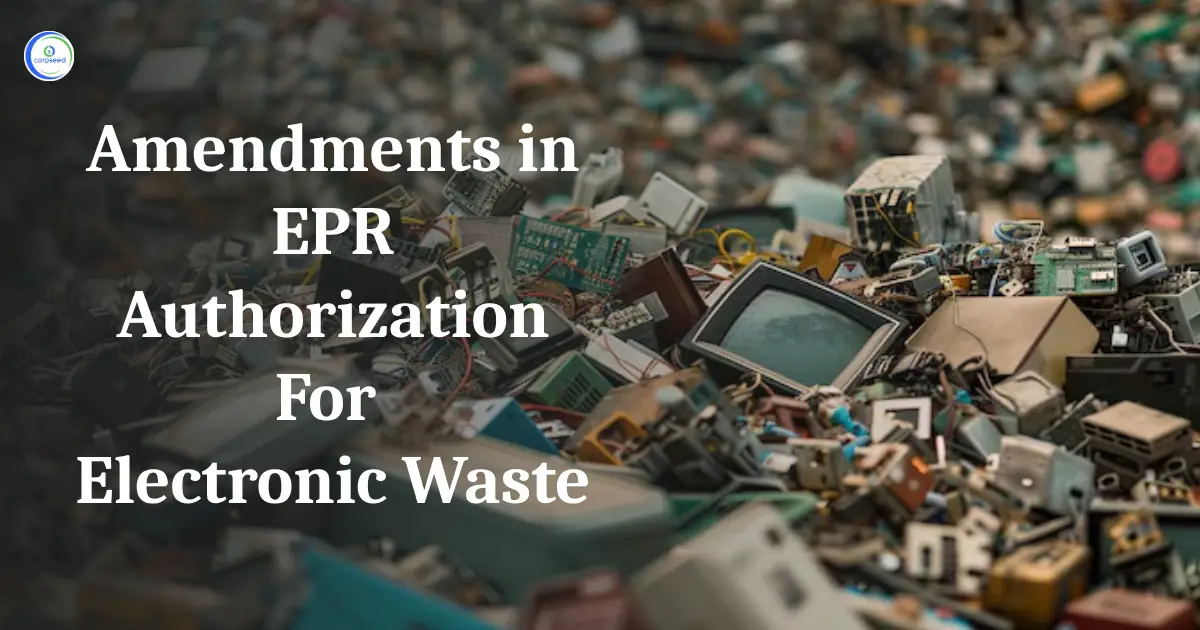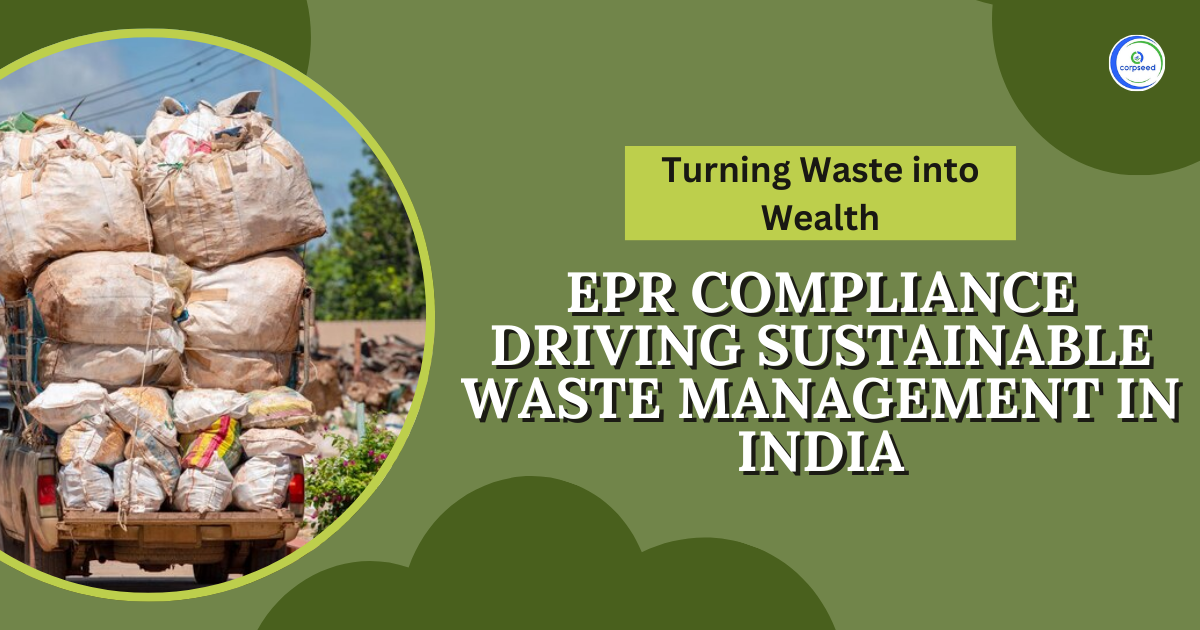Introduction: E-Waste Management
E-Waste Management - What is Extended Producer Responsibility (EPR) for electronic and electric items In India?
Electronic items have not just become a fundamental piece of our lives, yet additionally, contribute essentially to ecological outcomes. For the duration of our lives, we are needy upon an innumerable number of electrical and electronic items yet we don't consider what befalls these merchandise once they become outdated or disposed of. The utilization of electronic products has multiplied in ongoing decades and proportionality, the amount of electronic merchandise that are discarded is developing quickly all through the world. Electronic waste or e-waste is a rising issue in creating and creating nations around the world.
Table of Contents
--------------Blog Contact Form-------------
According to New 2018 Guidelines, to Get EPR for E-waste Management
- Producers will need to apply for and approval for age/stockpiling/treatment/removal of e-waste during the assembling of any electrical and electronic hardware in Form 1(a) under sub-rule (2) of rule 13 to the concerned State Pollution Control Board (SPCB).
- Each producer of electrical and electronic hardware recorded in plan 1 will make an application for EPR-Authorization in Form-1 to the Central Pollution Control Board (CPCB) alongside EPR Authorization plan
E-Waste (Management) Rules, 2016
- Producer, vendor, and Producer Responsibility Organization (PRO) have been presented as extra partners in the standards.
- The appropriateness of the principles has been stretched out to segments, consumables, extras, and parts of EEE notwithstanding hardware as recorded in Schedule I.
- Smaller Fluorescent Lamps (CFL) and other mercury-containing lights are brought under the domain of rules.
- Assortment component-based methodology has been embraced to incorporate assortment community, assortment point, reclaim framework and so on for assortment of e - squander by Producers under Extended Producer Responsibility (EPR).
- Choice has been surrendered for setting of PRO, e-squander trade, e-retailer, and Deposit Refund Scheme as extra channel for execution of EPR by Producers to guarantee proficient channelization of e-squander.
- Arrangement for Pan India EPR Authorization by CPCB has been presented supplanting the state shrewd EPR approval.
- Assortment and channelization of e-squander in Extended Producer Responsibility - Authorization will be In line with the objectives endorsed in Schedule III of the Rules. The stage shrewd Collection Target for e - squander, which can be either in number or Weight will be 30% of the amount of waste age as demonstrated in EPR Plan during initial multiyear of execution of rules followed by 40% during the third and fourth years, half during fifth and 6th years and 70% during seventh year onwards.
- Store Refund Scheme has been presented as an extra monetary instrument wherein the producer charges an extra sum as a store at the hour of offer of the electrical and electronic gear and returns it to the purchaser alongside intrigue when the end-of-life electrical and electronic hardware is returned.
- The e -waste trade as a choice has been given in the principles as an autonomous market instrument offering help or free electronic frameworks offering administrations available to be purchased and acquisition of e - squander created from end-of-life electrical and electronic gear between offices or associations approved under these guidelines.
- The producer is additionally now capable to gather e - squander created during the assembling of any electrical and electronic gear and channelise it for reusing or removal and look for approval from SPCB.
- The seller, if has been given the duty of assortment in the interest of the producer, need to gather the e - waste by giving the customer a case and channelize it to Producer.
- Seller or retailer or e - retailer will discount the sum according to reclaim framework or De place Refund Scheme of the producer to the investor of e - squander.
- Refurbisher need gather e - squander produced during the way toward restoring and channelize the loss to approved dismantler or recycler through its assortment place and look for one-time approval from SPCB.
- The jobs of the State Government has been additionally presented in the Rules so as to guarantee wellbeing, wellbeing and ability improvement of the laborers associated with the disassembling and reusing tasks.
- Division of Industry in State or some other government office approved right now the State Government is to guarantee reserving or allotment of modern space or shed for e - squander destroying and reusing in the current and up and coming mechanical park, home and modern bunches.
- Branch of Labor in the State or any other government organization approved right now the State Government need to guarantee acknowledgment and enrollment of laborers associated with destroying and reusing; help arrangement of gatherings of such specialists to encourage setting up disassembling offices; attempt mechanical expertise improvement exercises for the laborers engaged with destroying and reusing; and embrace yearly observing and to guarantee security and strength of laborers associated with destroying and reusing.
- State Government to get a ready coordinated arrangement for viable usage of these arrangements, and to submit a yearly report to Ministry of Environment, Forest and Climate Change.
- The transportation of e - squander will be done according to the show framework whereby the transporter will be required to convey a record (three duplicates) arranged by the sender, giving the subtleties.
- Obligation for harms caused to the earth or outsider because of ill-advised administration of e - squander including arrangement for demanding money related punishment for infringement of arrangements of the Rules has likewise been presented.
- Urban Local Bodies (Municipal Committee/Council/Corporation) has been relegating the obligation to gather and channelize the vagrant items to approved dismantler or recycler.
E-Waste (Management) Rules, 2018
Some salient features of the Amendment Rules are —
The E-Waste Management Rules 2016 have been corrected vide notice G.S.R. 261(E), dated March 22, 2018. The correction in rules has been finished with the goal of channelizing the E-waste created in the nation towards approved dismantlers and recyclers so as to formalize the e-waste reusing part. The assortment focuses under the arrangement of Extended Producer Responsibility (EPR) in the Rules that have been reconsidered and targets have been presented for new producers who have begun their business tasks as of late.
A portion of the remarkable highlights of the E-waste (Management) Amendment Rules, 2018 are as per the following:
The e-waste assortment focuses under EPR have been updated and will be material from 1 October 2017. The stage astute assortment focuses on e-waste in weight will be 10% of the amount of waste age as demonstrated in the EPR Plan during 2017-18, with a 10% expansion consistently until 2023. From 2023 onwards, the objective has been made 70% of the amount of waste age as demonstrated in the EPR Plan.
The amount of e-waste gathered by producers from 1 October 2016 to 30 September 2017 will be represented in the reconsidered EPR focuses until March 2018.
Separate e-waste assortment targets have been drafted for new producers, for example, those producers whose number of long periods of deals activity is not exactly the normal existence of their items. The normal existence of the items will be according to the rules given by CPCB every now and then.
The Producer Responsibility Organizations will apply to the Central Pollution Control board (CPCB) for enlistment to embrace exercises endorsed in the Rules.
Under the Reduction of Hazardous Substances (RoHS) arrangements, the cost for examining and testing will be borne by the legislature for directing the RoHS test. In the event that the item doesn't conform to RoHS arrangements, at that point, the expense of the test will be borne by the Producers.
This portion of the site is for informational purposes only. The content is not legal advice. The statements and opinions are the expression of author, not corpseed, and have not been evaluated by corpseed for accuracy, completeness, or changes in the law.
BOOK A FREE CONSULTATION
Get help from an experienced legal adviser. Schedule your consultation at a time that works for you and it's absolutely FREE.





.webp)



